高中英语人教新课标选修六Unit3A healthy life-Grammar(it的用法)课件(36张ppt)
文档属性
| 名称 | 高中英语人教新课标选修六Unit3A healthy life-Grammar(it的用法)课件(36张ppt) | 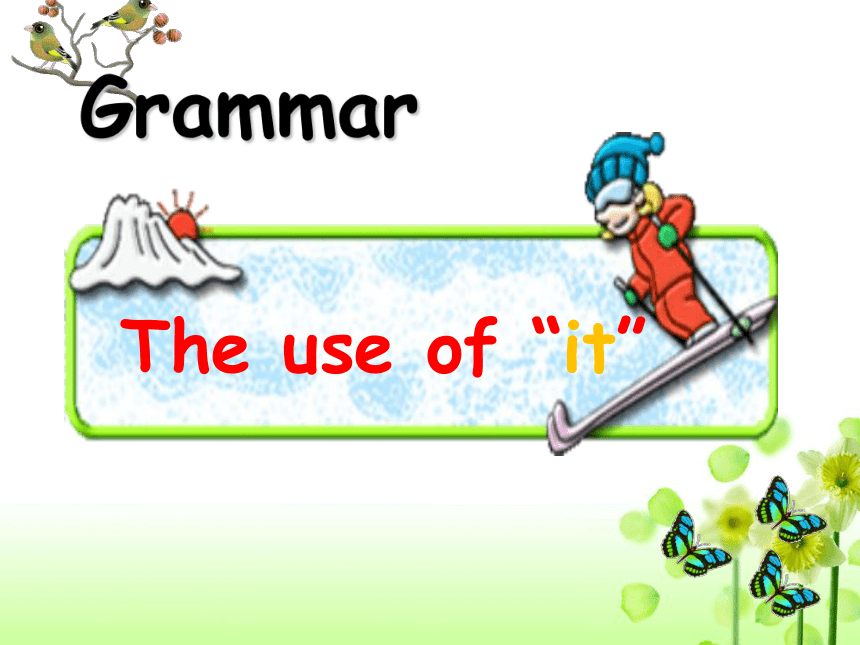 | |
| 格式 | zip | ||
| 文件大小 | 406.7KB | ||
| 资源类型 | 教案 | ||
| 版本资源 | 人教版(新课程标准) | ||
| 科目 | 英语 | ||
| 更新时间 | 2021-12-30 10:23:41 | ||
图片预览

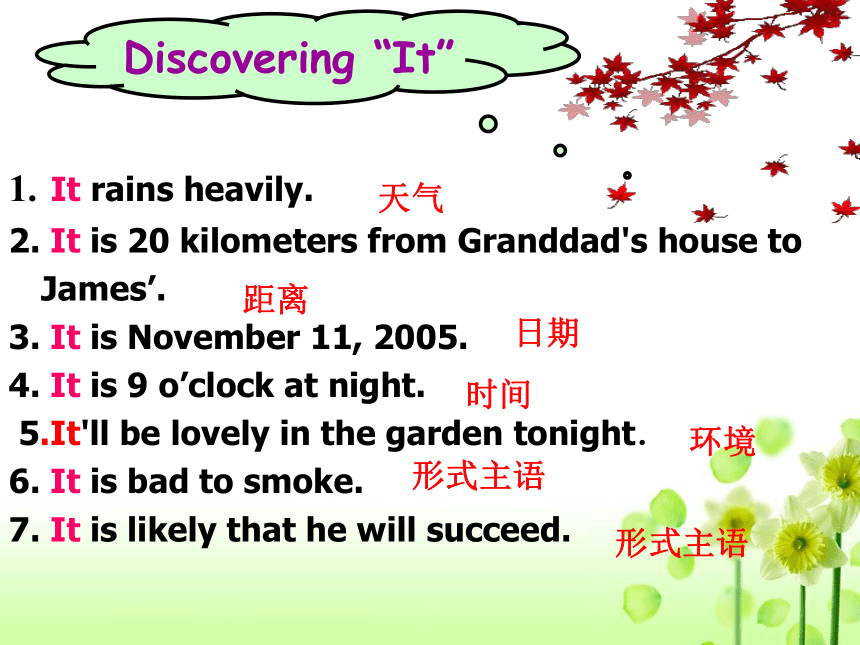
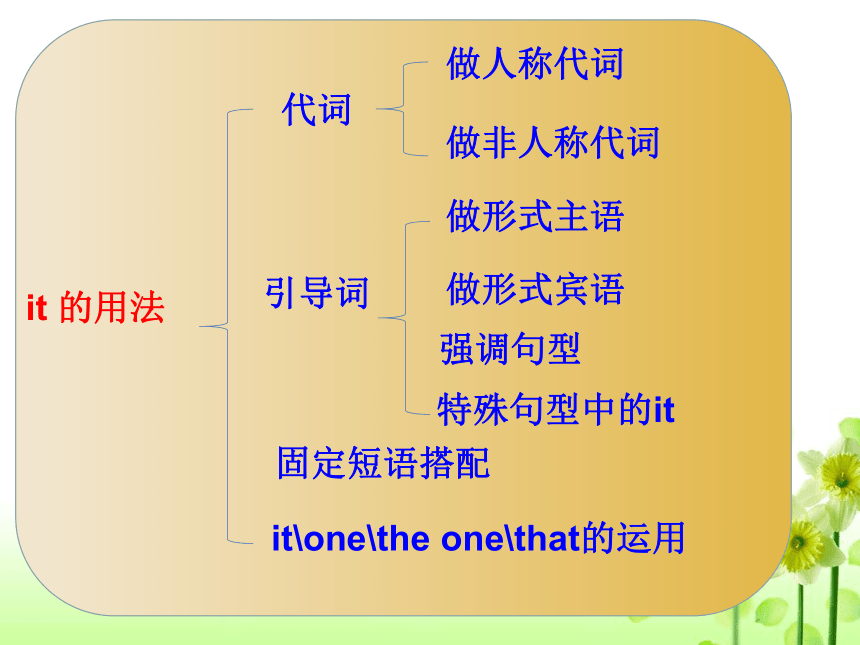
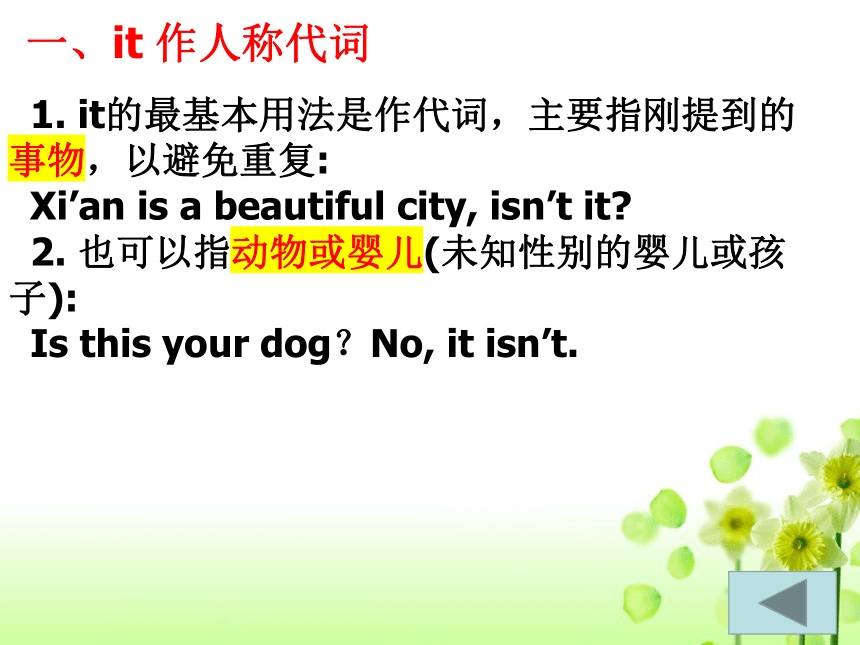
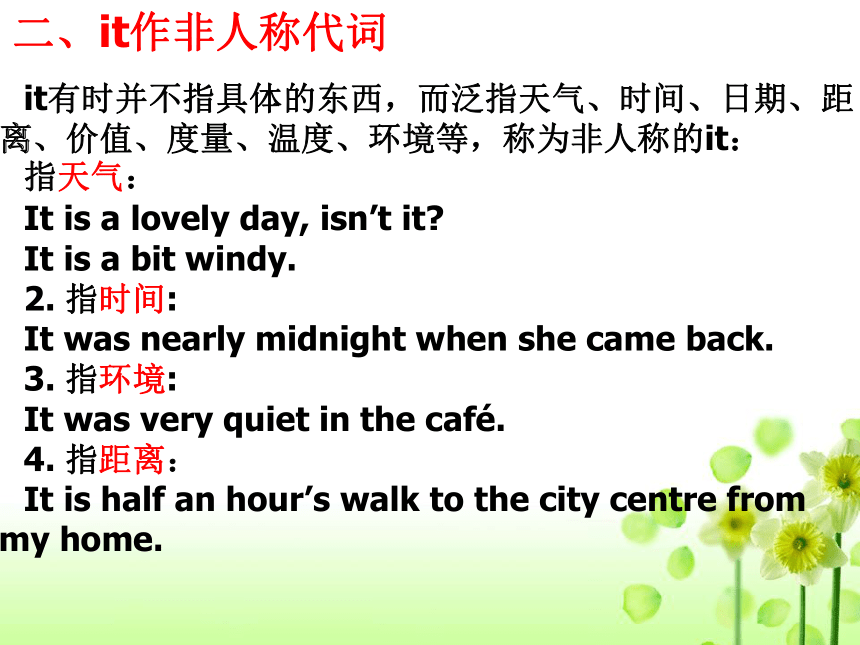
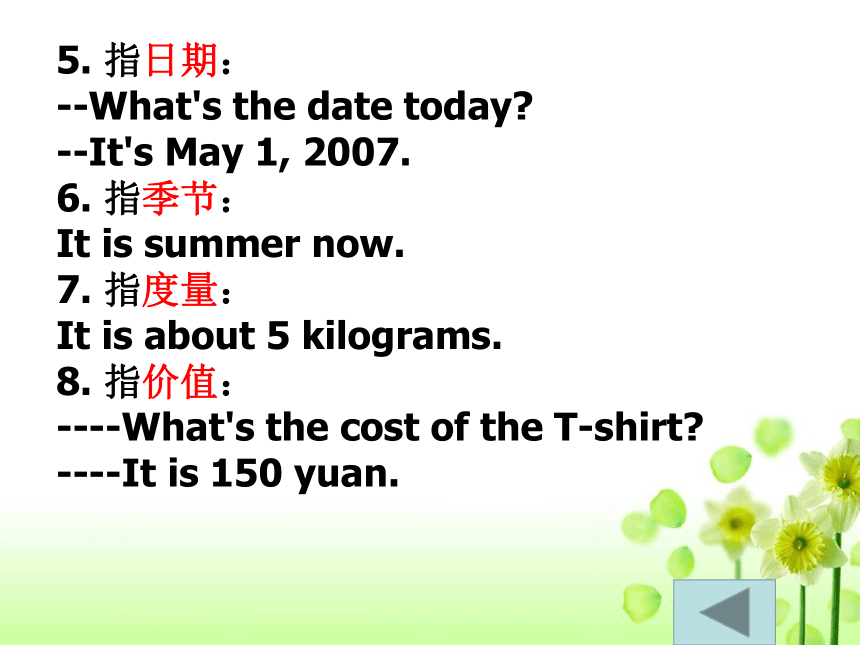
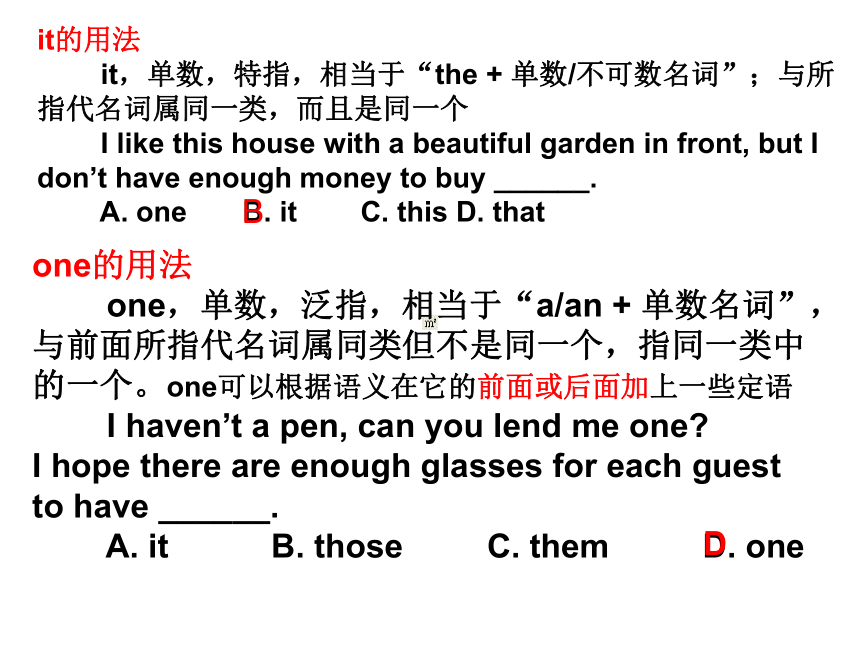
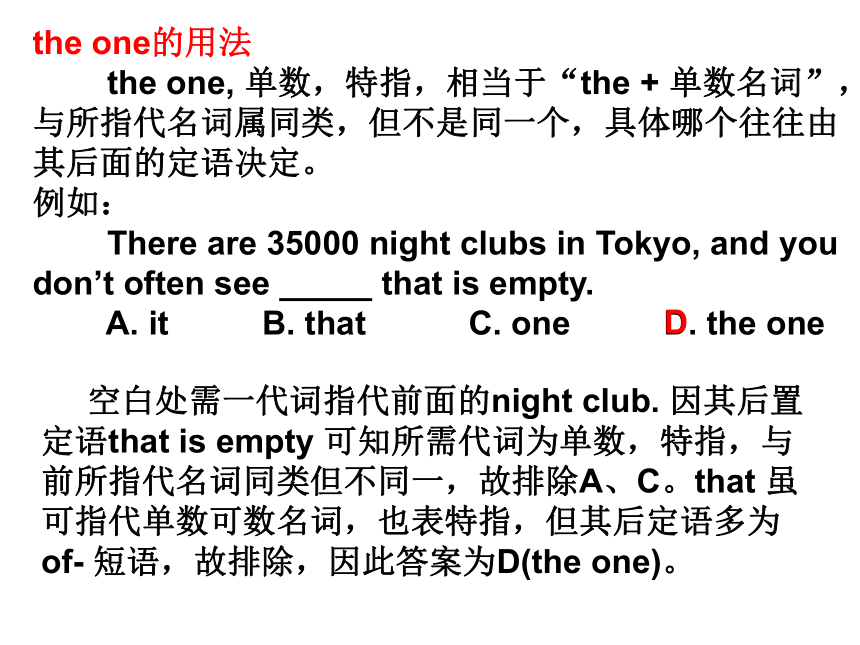
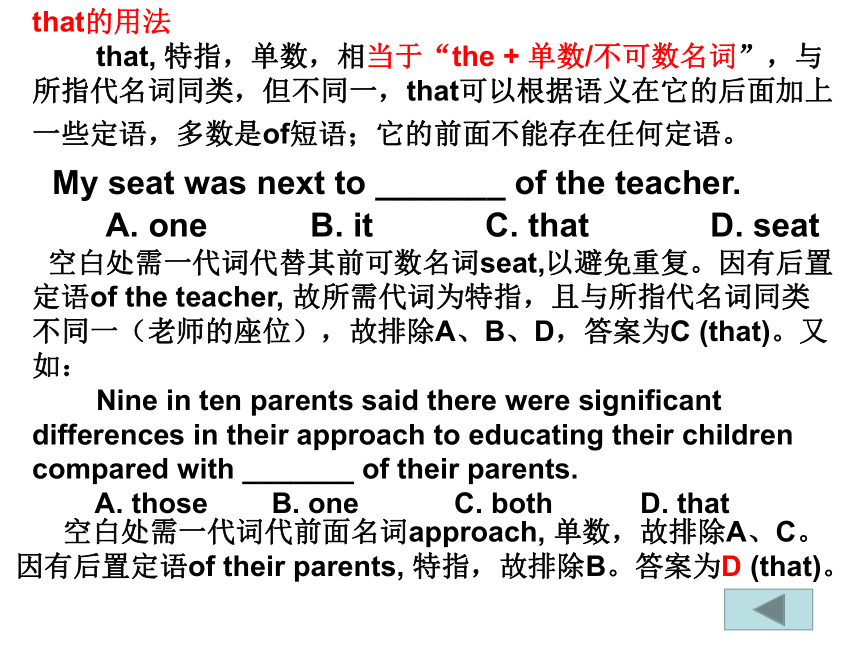
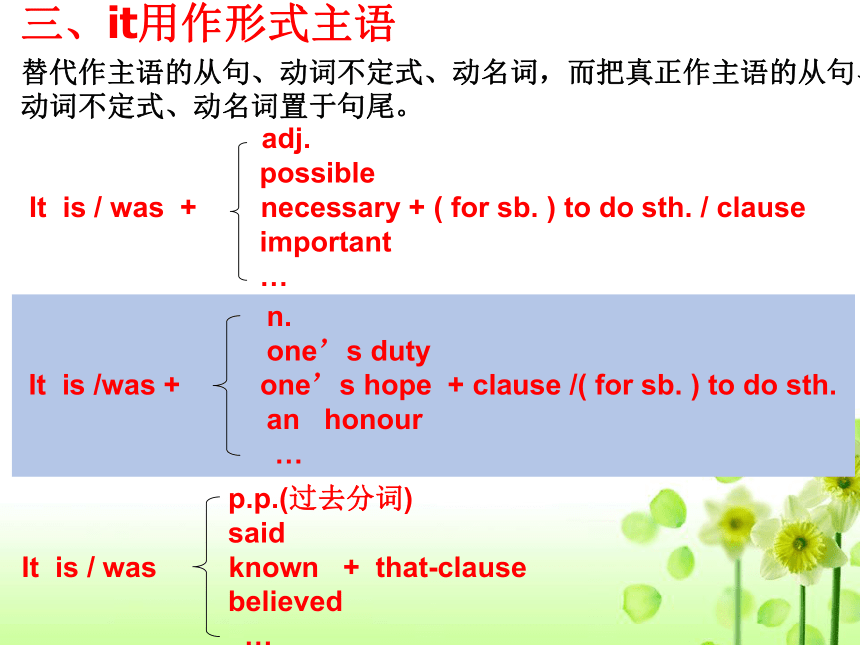
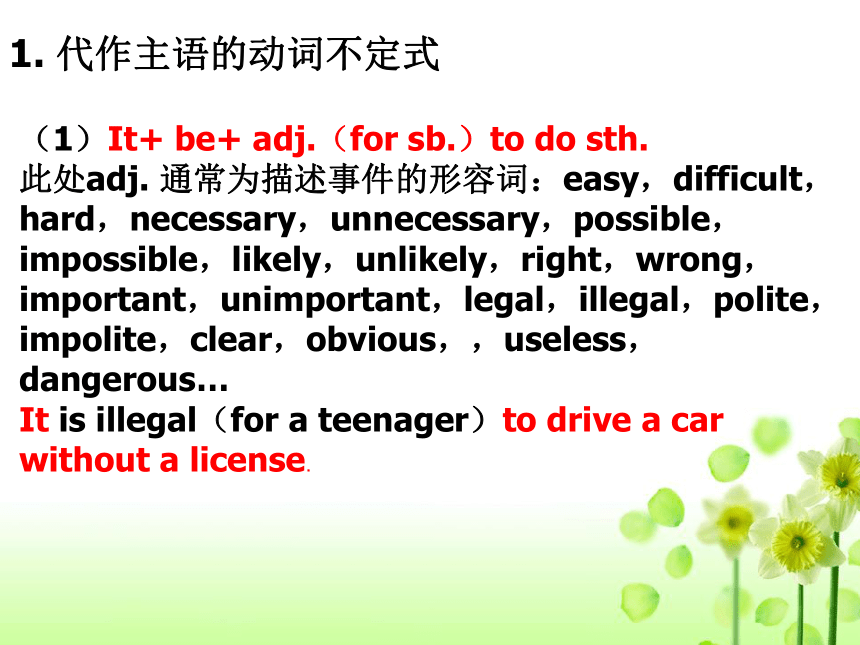
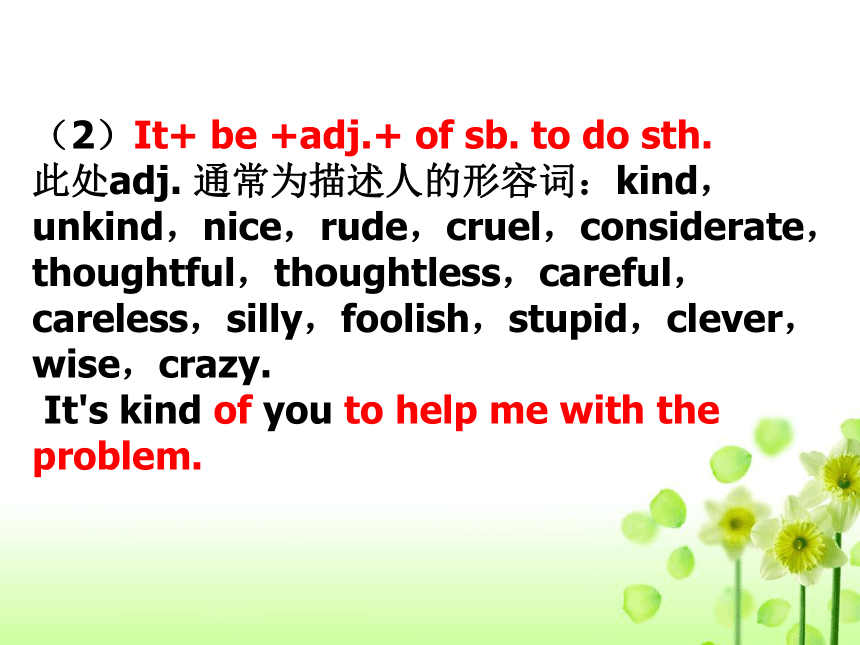
文档简介
(共36张PPT)
The use of “it”
Grammar
Discovering “It”
It rains heavily.
2. It is 20 kilometers from Granddad's house to James’.
3. It is November 11, 2005.
4. It is 9 o’clock at night.
5.It'll be lovely in the garden tonight.
6. It is bad to smoke.
7. It is likely that he will succeed.
天气
距离
日期
时间
形式主语
环境
形式主语
it 的用法
做人称代词
做非人称代词
做形式主语
做形式宾语
特殊句型中的it
代词
引导词
强调句型
固定短语搭配
itonethe onethat的运用
1. it的最基本用法是作代词,主要指刚提到的事物,以避免重复:
Xi’an is a beautiful city, isn’t it
2. 也可以指动物或婴儿(未知性别的婴儿或孩子):
Is this your dog?No, it isn’t.
一、it 作人称代词
it有时并不指具体的东西,而泛指天气、时间、日期、距离、价值、度量、温度、环境等,称为非人称的it:
指天气:
It is a lovely day, isn’t it
It is a bit windy.
2. 指时间:
It was nearly midnight when she came back.
3. 指环境:
It was very quiet in the café.
4. 指距离:
It is half an hour’s walk to the city centre from my home.
二、it作非人称代词
5. 指日期:
--What's the date today
--It's May 1, 2007.
6. 指季节:
It is summer now.
7. 指度量:
It is about 5 kilograms.
8. 指价值:
----What's the cost of the T-shirt
----It is 150 yuan.
it的用法
it,单数,特指,相当于“the + 单数/不可数名词”;与所指代名词属同一类,而且是同一个
I like this house with a beautiful garden in front, but I don’t have enough money to buy ______.
A. one B. it C. this D. that
one的用法
one,单数,泛指,相当于“a/an + 单数名词”,与前面所指代名词属同类但不是同一个,指同一类中的一个。one可以根据语义在它的前面或后面加上一些定语
I haven’t a pen, can you lend me one
I hope there are enough glasses for each guest to have ______.
A. it B. those C. them D. one
D
B
the one的用法
the one, 单数,特指,相当于“the + 单数名词”,与所指代名词属同类,但不是同一个,具体哪个往往由其后面的定语决定。
例如:
There are 35000 night clubs in Tokyo, and you don’t often see _____ that is empty.
A. it B. that C. one D. the one
空白处需一代词指代前面的night club. 因其后置定语that is empty 可知所需代词为单数,特指,与前所指代名词同类但不同一,故排除A、C。that 虽可指代单数可数名词,也表特指,但其后定语多为of- 短语,故排除,因此答案为D(the one)。
D
that的用法
that, 特指,单数,相当于“the + 单数/不可数名词”,与所指代名词同类,但不同一,that可以根据语义在它的后面加上一些定语,多数是of短语;它的前面不能存在任何定语。
My seat was next to _______ of the teacher.
A. one B. it C. that D. seat
空白处需一代词代替其前可数名词seat,以避免重复。因有后置定语of the teacher, 故所需代词为特指,且与所指代名词同类不同一(老师的座位),故排除A、B、D,答案为C (that)。又如:
Nine in ten parents said there were significant differences in their approach to educating their children compared with _______ of their parents.
A. those B. one C. both D. that
空白处需一代词代前面名词approach, 单数,故排除A、C。因有后置定语of their parents, 特指,故排除B。答案为D (that)。
替代作主语的从句、动词不定式、动名词,而把真正作主语的从句、动词不定式、动名词置于句尾。
三、it用作形式主语
adj.
possible
It is / was + necessary + ( for sb. ) to do sth. / clause
important
…
p.p.(过去分词)
said
It is / was known + that-clause
believed
…
n.
one’s duty
It is /was + one’s hope + clause /( for sb. ) to do sth.
an honour
…
(1)It+ be+ adj.(for sb.)to do sth.
此处adj. 通常为描述事件的形容词:easy,difficult,hard,necessary,unnecessary,possible,impossible,likely,unlikely,right,wrong,important,unimportant,legal,illegal,polite,impolite,clear,obvious,,useless,dangerous…
It is illegal(for a teenager)to drive a car without a license.
1. 代作主语的动词不定式
(2)It+ be +adj.+ of sb. to do sth.
此处adj. 通常为描述人的形容词:kind,unkind,nice,rude,cruel,considerate,thoughtful,thoughtless,careful,careless,silly,foolish,stupid,clever,wise,crazy.
It's kind of you to help me with the problem.
It's no good/use /great fun doing…
It's(well)worth doing…
It's(well)worthwhile doing/ to do
It's no use crying over spilt milk.
(3) It替代作主语的动名词的常见句型
2. it作形式主语替代主语从句
It is clear ( obvious,true,possible, certain …) that ...
该句型中it 是形式主语,真正的主语是that 引导的主语从句,常译为“清楚(显然, 真的……)”
是主语从句最常见的一种结构。例如:
It is very clear that he’s round and tall like a tree.
①It+ is+ adj. +that clause
It is said (reported/ learned/believed
/thought/known/told/hoped.....) that ...
该句型中的it 仍是形式主语,真正主语是that 引导的主语从句;该结构常译为“据说(据报道,据悉...)”。
It is said that he has come to Beijing.
It is reported that another earth satellite has been put into orbit.
②It +is +v-ed that…=sb./sth. is to do
It +不及物动词+that从句
此句型中不及物动词常见的有:seem, happen, appear, matter等。如:
It seems that there will be a heavy snow tomorrow.
It happened that I met my good friends in the museum yesterday.
③ It +is + noun +从句
It is a pity (a shame /an honor /a good thing/a fact /a surprise/... ) that ...
该句型中,that后的从句一般用虚拟语气(should + 动词原形),should可省去.表示出乎意料,常译为“竟然”。没有这种意义时,则不用虚拟语气。例如:
It is a pity that such a thing (should) happen in your class.
这种事竟然发生在你们班上,真是遗憾!
It is a pity that he is ill. 他生病了,真遗憾!
it作形式宾语
1.当复合宾语中的宾语是不定式、动名词宾语从句时,往往把宾语放在它的补足语后面,而用it 作形式宾语,放在宾语补足语之前。
6个主句中常用的动词:
think,believe,make,find,consider,feel;
1 形式宾语it;
2 宾补的两种形式:形容词或名词;
3 真正宾语的三种形式:
①不定式短语 ②动名词短语 ③that引导的宾语从句
it 作形式宾语,记忆方便---“6123结构”。
句型:主语+动词+it +adj./n.+(for sb.) to do/doing/that从句
I think it no use arguing with him.
我认为和他争吵没有用。
I found it very interesting to study
English.
我发现学英语非常有趣。
He made it clear that he was not
interested in this subject.
他非常清楚地表示他对那门学科不感兴趣。
I like___in the autumn when the weather is clear and bright.
A. this B. that C. it D. one
点拨:这是it作形式宾语的一种特殊用法.少数动词(如like, love, enjoy, dislike, hate,help, appreciate等)或包含介词的动词短语(如see to, depend on,count on等)后接宾语从句,必须先由it担任形式宾语,再接从句.
I like (enjoy, hate…) it when….
I would appreciate it if…
…see to (depend on…) it that…
Sentence patterns:
C
形式宾语特殊用法1
I hate it you can dance so well but I can't.
I would appreciate it if you lend me some money.
I enjoy it when we are bathing in the sunshine.
He decided on it where we would go this weekend..
动词 +it + to sb. + that…
owe it to sb. that…把…归功于…
leave it to sb that…把…留给某人去做
take it for granted that 把…想当然
keep it in mind that… 把…记在心里
他想当然地以为女朋友会再回来。
He took it for granted that his girlfriend would come back again.
形式宾语特殊用法2
五、用于强调句型中
It is/was + 被强调部分 + that/who ...
It is not until + 被强调部分 + that ...
I met Tom in the park yesterday.
1) It was I who met Tom in the park yesterday.
2) It was Tom who I met in the park yesterday.
3) It was in the park that I met Tom yesterday.
4) It was yesterday that I met Tom in the park.
It was five o’clock _________I got home.
It was at five o’clock_______ I got home.
when
that
强调句用以强调主语,宾语,介词宾语以及状语。(强调人时用that和who /whom皆可)
It was she who /that had been wrong.
是她错了。 ( )
It was the girl whom /that I met just now.
我刚才遇见的就是这个女孩。 ( )
It was Tom to whom the teacher had talked.
老师与其谈话的那个人是汤姆。 ( )
It was on Monday night that all this happened.
所有这一切就是在星期一的晚上发生的。( )
主语
宾语
介词宾语
状语
It was not until + 被强调部分 + that ...
该句型也是强调句型。主要用于强凋时间状语,译成汉语 “直到……才……”,可以说是not ... until ... 的强调形式。例如:
= I didn’t realize she was a famous film star until she took off her dark glasses.
It was not until she took off her dark glasses that I realized she was a famous film star.
= Not until she took off her dark glasses did I realize she was a famous film star.
含有 it 的其它句型:
1.It is time (for sb.) to do sth.
2.It is (high) time that sb. did sth.(虚拟语气)
3.It is/has been +段 时间 + since … 从……已多久了。
It is five months since I arrived in New York.我到纽约已经五个月了。
It is five months since I was in New York.我离开纽约已经五个月了。
(注意:终止性动词表示从动作发生时算起;如果是状态动词或持续性动词,则从动作或状态结束时算起。)
4.It was/will be + 时间 + before …
这个句型中时间是时间段,如long、years、months、weeks、five days、three hours、twenty minutes等。不过主句的时态多用一般将来时或一般过去时。“…之后才”,“没过……就……”
It will be several years before we meet again.
我们要过好几年才能再见面。
It was not long before they set out for the front.
不久他们就出发去了前线。
5.It is /was/ the first/second/third … time that …
It is the first time that I have been here.
It was the second time that he had seen the film.
6.It is up to sb. to do sth … 应由某人做某事。
It is up to you to decide whether we start or not.
7.It takes sb.+一段时间+to do sth.表示“做某事花费某人多长时间”。如:
It took us half an hour to ride to the town by the
sea.
8. it is +具体的时间…..+when…
该句型中的when引导的是一个时间状语从句,主句中的it指时间,表语由具体的时间充当。常译为“当……的时候,是……”
It was 11 o’clock when he came back.
四、it固定用法:
How is it with your study 学习好吗?
That’s it . 这就对了。
It went hard with him. 他身遇不幸。
It is all over with me. 我完蛋了。
We must fight it out.我们必须坚持到底。
I can’t help it. 我没有办法。
1. It的一些习惯用法
常见的固定用法有:
make it 成功,安排在或定在某时间
forget it 别提了,忘了它吧, 算了
Don’t mention it 别提了,表示不用谢
It doesn’t matter 没关系
It(That) depends 视情况而定
You guessed it 你猜着了
It’s hard to say 很难说
It’s up to you to do sth.由你来决定做某事
2.在一些固定用法中考查
I. 单项选择
1. He didn’t make ____ clear when and where the meeting would be held.
(天津)
A. this B. that C. it D. these
2. ____ is our belief that improvements in health care will lead to a stronger, more prosperous economy. (浙江)
A. As B. That C. This D. It
高考实例
3. The doctor advised Vera strongly that she should take a holiday, but ______ didn’t help. (全国卷III)
A. it B. she C. which D. he
4. I’d appreciate ______ if you would like to teach me how to use the computer. (山东)
A. that B. it C. this D. you
2.完成句子
1. (我发现很难) to get up early in
such cold days.
2. (是第一次) I have heard
of the rules for exercises.
3. How far (到学校)
4. (没关系) to me what you do.
5. (真遗憾) that such a thing
happen in such an occasion.
6. (冬季里躺在阳光下)is
pleasant.
7. (直到1936年) that basketball
became a regular part of the Olympic Games.
8. (接近半夜) when she came
back.
I found it hard
It is the first time that
is it to the school
It doesn’t matter
It is a pity
Lying in the sun in winter
It was not until 1936
It was nearly midnight
3、把下列各句转换成用it作形式主语的句子
1. To say is easy, but to do is difficult.
___________________________________________
2. He was clever to say so.
___________________________________________
3. Trying to drown your sorrows in drink is of no use.
___________________________________________
4. Some people say that more than 30,000 people died in the flood.
___________________________________________
5. When and where to hold the meeting hasn't been decided.
__________________________________________
It is easy to say, but it is difficult to do.
It was of him to say so.
It is no use trying to drown your sorrows in drink.
It is said that more than 30,000 people died in the flood.
It hasn’t been decided when and where to hold the meeting.
See you next time!
The use of “it”
Grammar
Discovering “It”
It rains heavily.
2. It is 20 kilometers from Granddad's house to James’.
3. It is November 11, 2005.
4. It is 9 o’clock at night.
5.It'll be lovely in the garden tonight.
6. It is bad to smoke.
7. It is likely that he will succeed.
天气
距离
日期
时间
形式主语
环境
形式主语
it 的用法
做人称代词
做非人称代词
做形式主语
做形式宾语
特殊句型中的it
代词
引导词
强调句型
固定短语搭配
itonethe onethat的运用
1. it的最基本用法是作代词,主要指刚提到的事物,以避免重复:
Xi’an is a beautiful city, isn’t it
2. 也可以指动物或婴儿(未知性别的婴儿或孩子):
Is this your dog?No, it isn’t.
一、it 作人称代词
it有时并不指具体的东西,而泛指天气、时间、日期、距离、价值、度量、温度、环境等,称为非人称的it:
指天气:
It is a lovely day, isn’t it
It is a bit windy.
2. 指时间:
It was nearly midnight when she came back.
3. 指环境:
It was very quiet in the café.
4. 指距离:
It is half an hour’s walk to the city centre from my home.
二、it作非人称代词
5. 指日期:
--What's the date today
--It's May 1, 2007.
6. 指季节:
It is summer now.
7. 指度量:
It is about 5 kilograms.
8. 指价值:
----What's the cost of the T-shirt
----It is 150 yuan.
it的用法
it,单数,特指,相当于“the + 单数/不可数名词”;与所指代名词属同一类,而且是同一个
I like this house with a beautiful garden in front, but I don’t have enough money to buy ______.
A. one B. it C. this D. that
one的用法
one,单数,泛指,相当于“a/an + 单数名词”,与前面所指代名词属同类但不是同一个,指同一类中的一个。one可以根据语义在它的前面或后面加上一些定语
I haven’t a pen, can you lend me one
I hope there are enough glasses for each guest to have ______.
A. it B. those C. them D. one
D
B
the one的用法
the one, 单数,特指,相当于“the + 单数名词”,与所指代名词属同类,但不是同一个,具体哪个往往由其后面的定语决定。
例如:
There are 35000 night clubs in Tokyo, and you don’t often see _____ that is empty.
A. it B. that C. one D. the one
空白处需一代词指代前面的night club. 因其后置定语that is empty 可知所需代词为单数,特指,与前所指代名词同类但不同一,故排除A、C。that 虽可指代单数可数名词,也表特指,但其后定语多为of- 短语,故排除,因此答案为D(the one)。
D
that的用法
that, 特指,单数,相当于“the + 单数/不可数名词”,与所指代名词同类,但不同一,that可以根据语义在它的后面加上一些定语,多数是of短语;它的前面不能存在任何定语。
My seat was next to _______ of the teacher.
A. one B. it C. that D. seat
空白处需一代词代替其前可数名词seat,以避免重复。因有后置定语of the teacher, 故所需代词为特指,且与所指代名词同类不同一(老师的座位),故排除A、B、D,答案为C (that)。又如:
Nine in ten parents said there were significant differences in their approach to educating their children compared with _______ of their parents.
A. those B. one C. both D. that
空白处需一代词代前面名词approach, 单数,故排除A、C。因有后置定语of their parents, 特指,故排除B。答案为D (that)。
替代作主语的从句、动词不定式、动名词,而把真正作主语的从句、动词不定式、动名词置于句尾。
三、it用作形式主语
adj.
possible
It is / was + necessary + ( for sb. ) to do sth. / clause
important
…
p.p.(过去分词)
said
It is / was known + that-clause
believed
…
n.
one’s duty
It is /was + one’s hope + clause /( for sb. ) to do sth.
an honour
…
(1)It+ be+ adj.(for sb.)to do sth.
此处adj. 通常为描述事件的形容词:easy,difficult,hard,necessary,unnecessary,possible,impossible,likely,unlikely,right,wrong,important,unimportant,legal,illegal,polite,impolite,clear,obvious,,useless,dangerous…
It is illegal(for a teenager)to drive a car without a license.
1. 代作主语的动词不定式
(2)It+ be +adj.+ of sb. to do sth.
此处adj. 通常为描述人的形容词:kind,unkind,nice,rude,cruel,considerate,thoughtful,thoughtless,careful,careless,silly,foolish,stupid,clever,wise,crazy.
It's kind of you to help me with the problem.
It's no good/use /great fun doing…
It's(well)worth doing…
It's(well)worthwhile doing/ to do
It's no use crying over spilt milk.
(3) It替代作主语的动名词的常见句型
2. it作形式主语替代主语从句
It is clear ( obvious,true,possible, certain …) that ...
该句型中it 是形式主语,真正的主语是that 引导的主语从句,常译为“清楚(显然, 真的……)”
是主语从句最常见的一种结构。例如:
It is very clear that he’s round and tall like a tree.
①It+ is+ adj. +that clause
It is said (reported/ learned/believed
/thought/known/told/hoped.....) that ...
该句型中的it 仍是形式主语,真正主语是that 引导的主语从句;该结构常译为“据说(据报道,据悉...)”。
It is said that he has come to Beijing.
It is reported that another earth satellite has been put into orbit.
②It +is +v-ed that…=sb./sth. is to do
It +不及物动词+that从句
此句型中不及物动词常见的有:seem, happen, appear, matter等。如:
It seems that there will be a heavy snow tomorrow.
It happened that I met my good friends in the museum yesterday.
③ It +is + noun +从句
It is a pity (a shame /an honor /a good thing/a fact /a surprise/... ) that ...
该句型中,that后的从句一般用虚拟语气(should + 动词原形),should可省去.表示出乎意料,常译为“竟然”。没有这种意义时,则不用虚拟语气。例如:
It is a pity that such a thing (should) happen in your class.
这种事竟然发生在你们班上,真是遗憾!
It is a pity that he is ill. 他生病了,真遗憾!
it作形式宾语
1.当复合宾语中的宾语是不定式、动名词宾语从句时,往往把宾语放在它的补足语后面,而用it 作形式宾语,放在宾语补足语之前。
6个主句中常用的动词:
think,believe,make,find,consider,feel;
1 形式宾语it;
2 宾补的两种形式:形容词或名词;
3 真正宾语的三种形式:
①不定式短语 ②动名词短语 ③that引导的宾语从句
it 作形式宾语,记忆方便---“6123结构”。
句型:主语+动词+it +adj./n.+(for sb.) to do/doing/that从句
I think it no use arguing with him.
我认为和他争吵没有用。
I found it very interesting to study
English.
我发现学英语非常有趣。
He made it clear that he was not
interested in this subject.
他非常清楚地表示他对那门学科不感兴趣。
I like___in the autumn when the weather is clear and bright.
A. this B. that C. it D. one
点拨:这是it作形式宾语的一种特殊用法.少数动词(如like, love, enjoy, dislike, hate,help, appreciate等)或包含介词的动词短语(如see to, depend on,count on等)后接宾语从句,必须先由it担任形式宾语,再接从句.
I like (enjoy, hate…) it when….
I would appreciate it if…
…see to (depend on…) it that…
Sentence patterns:
C
形式宾语特殊用法1
I hate it you can dance so well but I can't.
I would appreciate it if you lend me some money.
I enjoy it when we are bathing in the sunshine.
He decided on it where we would go this weekend..
动词 +it + to sb. + that…
owe it to sb. that…把…归功于…
leave it to sb that…把…留给某人去做
take it for granted that 把…想当然
keep it in mind that… 把…记在心里
他想当然地以为女朋友会再回来。
He took it for granted that his girlfriend would come back again.
形式宾语特殊用法2
五、用于强调句型中
It is/was + 被强调部分 + that/who ...
It is not until + 被强调部分 + that ...
I met Tom in the park yesterday.
1) It was I who met Tom in the park yesterday.
2) It was Tom who I met in the park yesterday.
3) It was in the park that I met Tom yesterday.
4) It was yesterday that I met Tom in the park.
It was five o’clock _________I got home.
It was at five o’clock_______ I got home.
when
that
强调句用以强调主语,宾语,介词宾语以及状语。(强调人时用that和who /whom皆可)
It was she who /that had been wrong.
是她错了。 ( )
It was the girl whom /that I met just now.
我刚才遇见的就是这个女孩。 ( )
It was Tom to whom the teacher had talked.
老师与其谈话的那个人是汤姆。 ( )
It was on Monday night that all this happened.
所有这一切就是在星期一的晚上发生的。( )
主语
宾语
介词宾语
状语
It was not until + 被强调部分 + that ...
该句型也是强调句型。主要用于强凋时间状语,译成汉语 “直到……才……”,可以说是not ... until ... 的强调形式。例如:
= I didn’t realize she was a famous film star until she took off her dark glasses.
It was not until she took off her dark glasses that I realized she was a famous film star.
= Not until she took off her dark glasses did I realize she was a famous film star.
含有 it 的其它句型:
1.It is time (for sb.) to do sth.
2.It is (high) time that sb. did sth.(虚拟语气)
3.It is/has been +段 时间 + since … 从……已多久了。
It is five months since I arrived in New York.我到纽约已经五个月了。
It is five months since I was in New York.我离开纽约已经五个月了。
(注意:终止性动词表示从动作发生时算起;如果是状态动词或持续性动词,则从动作或状态结束时算起。)
4.It was/will be + 时间 + before …
这个句型中时间是时间段,如long、years、months、weeks、five days、three hours、twenty minutes等。不过主句的时态多用一般将来时或一般过去时。“…之后才”,“没过……就……”
It will be several years before we meet again.
我们要过好几年才能再见面。
It was not long before they set out for the front.
不久他们就出发去了前线。
5.It is /was/ the first/second/third … time that …
It is the first time that I have been here.
It was the second time that he had seen the film.
6.It is up to sb. to do sth … 应由某人做某事。
It is up to you to decide whether we start or not.
7.It takes sb.+一段时间+to do sth.表示“做某事花费某人多长时间”。如:
It took us half an hour to ride to the town by the
sea.
8. it is +具体的时间…..+when…
该句型中的when引导的是一个时间状语从句,主句中的it指时间,表语由具体的时间充当。常译为“当……的时候,是……”
It was 11 o’clock when he came back.
四、it固定用法:
How is it with your study 学习好吗?
That’s it . 这就对了。
It went hard with him. 他身遇不幸。
It is all over with me. 我完蛋了。
We must fight it out.我们必须坚持到底。
I can’t help it. 我没有办法。
1. It的一些习惯用法
常见的固定用法有:
make it 成功,安排在或定在某时间
forget it 别提了,忘了它吧, 算了
Don’t mention it 别提了,表示不用谢
It doesn’t matter 没关系
It(That) depends 视情况而定
You guessed it 你猜着了
It’s hard to say 很难说
It’s up to you to do sth.由你来决定做某事
2.在一些固定用法中考查
I. 单项选择
1. He didn’t make ____ clear when and where the meeting would be held.
(天津)
A. this B. that C. it D. these
2. ____ is our belief that improvements in health care will lead to a stronger, more prosperous economy. (浙江)
A. As B. That C. This D. It
高考实例
3. The doctor advised Vera strongly that she should take a holiday, but ______ didn’t help. (全国卷III)
A. it B. she C. which D. he
4. I’d appreciate ______ if you would like to teach me how to use the computer. (山东)
A. that B. it C. this D. you
2.完成句子
1. (我发现很难) to get up early in
such cold days.
2. (是第一次) I have heard
of the rules for exercises.
3. How far (到学校)
4. (没关系) to me what you do.
5. (真遗憾) that such a thing
happen in such an occasion.
6. (冬季里躺在阳光下)is
pleasant.
7. (直到1936年) that basketball
became a regular part of the Olympic Games.
8. (接近半夜) when she came
back.
I found it hard
It is the first time that
is it to the school
It doesn’t matter
It is a pity
Lying in the sun in winter
It was not until 1936
It was nearly midnight
3、把下列各句转换成用it作形式主语的句子
1. To say is easy, but to do is difficult.
___________________________________________
2. He was clever to say so.
___________________________________________
3. Trying to drown your sorrows in drink is of no use.
___________________________________________
4. Some people say that more than 30,000 people died in the flood.
___________________________________________
5. When and where to hold the meeting hasn't been decided.
__________________________________________
It is easy to say, but it is difficult to do.
It was of him to say so.
It is no use trying to drown your sorrows in drink.
It is said that more than 30,000 people died in the flood.
It hasn’t been decided when and where to hold the meeting.
See you next time!
